The best way to prepare for boondocking is to just go do it. Start by camping in your RV or vehicle some place where you feel safe, spend a few days, and find out where you need to improve. One of the popular places to do this is at a highway rest area, in a state that allows overnight parking. You can also go an RV park and unplug from their water, electrical, and sewer and try a full day off-grid.
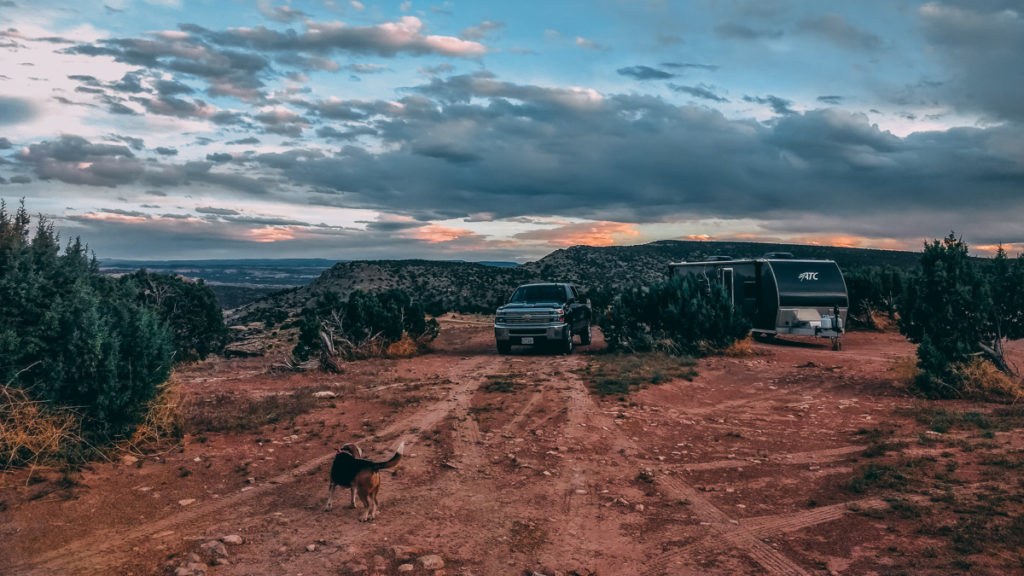
How Do You Prepare for Boondocking?
Most veteran boondockers started out by just doing it first, and then figured how where they needed to improve. That’s how we did it.
Otherwise, there are so many variables that you cannot possibly prepare yourself 100 percent before embarking on your first night of boondocking. A lot depends on the pros and cons of your RV, van, or car, that you’ll have to evaluate things for yourself.
We do, however, have plenty of suggestions to keep you thinking…
Heating
At the bare minimum, you just need warm clothes, thick socks, and comfy blankets to withstand the cold. Propane heaters, electrical heaters, and other fancy heating gadgets are luxuries, but are not really necessary.
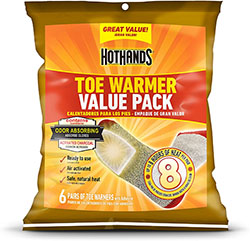
- Thick, heavy socks go a long way towards maintaining your internal body temperature. It’s always in your feet where blood cools down the most. If you can keep your feet toasty, the rest of your body does pretty well.
- HotHands sells “Toe Warmers” (see it on Amazon) which can be placed inside your socks, and will keep your feet toasty all night long.
- A down comforter will keep you warm in bed, on a couch, or the driver’s seat of your car, even in freezing temperatures.
Portable propane heaters are better than the furnace built-into your RV because they can be moved to any portion of your vehicle where you are. By contrast, an RV furnace heats up the entire vehicle, including the spaces where you are not present. Electric heaters are good, but only usable if you have a generator. Read, “How to Keep my Camper Warm in Winter“.
Your RV Furnace Might Not Run All Night Long
If your RV has a built-in furnace, you will also need adequate battery power. If you’ve always stayed at RV parks, the electrical hookup kept your batteries charged. But without that hookup, your battery bank may run out of power in the middle of the night.
Your RV battery bank is needed to power the furnace fan, the igniter, the furnace’s circuit board. The furnace fan uses a lot of power, and can drain a standard 12 volt battery (80-100 amp hours) in a couple of hours. We recommend having at least two of these batteries, at the very minimum. Better yet, get two six-volt golf cart batteries, they’ll power an RV furnace all through the night. Read, “Why Won’t My RV Furnace Stay On?“
How Much Propane Will You Need?
RV furnaces are propane hogs! A single 20 pound tank (5-gallons) will deplete after 3 nights of use. This includes also using the same tank to power your RV refrigerator, water heater, and occasional cook-top use. If you plan to use your RV furnace each night, keep an extra tank for every 3 nights of boondocking. For more on this read, “How Long Will a Propane Tank Last While Boondocking?“
Instead, we recommend using a portable propane heater. They are more efficient, and you can move the heater to the specific room you are in so that you are not wasting heat. For a list of our recommended portable propane heaters, read, “How to Keep my Camper Warm in Winter“.
Heating for Cars and Vans
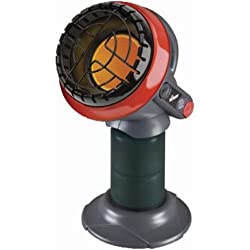
Most people who boondock inside their cars and vans have a small portable propane heater. Many use the “Mr. Heater Little Buddy” (see it on Amazon), which is a perfect size for cars and vans. It uses only a single propane canister, and will generally last about 7 hours. Note: even though the company says this heater is not to be used in vehicles, this is still what most people purchase for their car or van. You will need some kind of flat, stable surface to sit this on so that you don’t accidentally knock it over.
Cooling
Most boondockers rely on higher elevation to keep them cool. Find boondocking sites located at least 7,000 feet up, but higher the better. You can also try camping in forested areas where trees create a lot of shade, But ultimately, it’s high elevation that keeps you cool. Read our article, “10 Tips for Boondocking at High Altitude“.
Moreover, stay in areas with dry air. This is because humidity makes it terribly difficult to stay cool. Generally speaking, only camp west of the Rocky Mountain range (California, Arizona, Utah, New Mexico, Colorado, Wyoming, Montana, Idaho, Oregon, Washington).
For a long list of tips on how to stay cool while boondocking, read, “How Can I Stay Cool When Boondocking?“
Portable Air Conditioners
Most portable air conditioners require you to vent exhaust outdoors. The exhaust is just a combination of warm air and humidity. These units come with an exhaust hose that must be directed out of a window. Boondockers that don’t have a roof-mounted air conditioner will sometimes get a portable unit and figure out a way to create a vent.
The advantage of a portable air conditioner is that they use less electricity and can be directed to blow where you need it. You will need a generator to power these units. Some portable units can generate as many BTUs of cooling power as standard roof-mounted units (15,000 BTUs), but most boondockers with vans, slide-in campers, or other conversion RVs, will use a smaller portable unit between 5,000 to 8,000 BTUs.
You can also use Solar and Batteries to run a portable AC unit. Read our article, “How Many Batteries and Solar to Run a 5,000 BTU Portable Air Conditioner“.
Evaporative Coolers
Evaporative coolers (see it on Amazon) will also cool down the air, but consume much less electricity. In fact, many of these run on batteries. They use water to cool the air, and the cooler the water, the better. They also don’t need an exhaust vent.
However, because they are water-based, they do not remove humidity from the air. Allowing the air to remain humid is the primary reason why many people feel that evaporate coolers don’t work as effectively as air conditioning units.
RV Air Conditioners
Running the air conditioner on an RV’s roof is how most RV boondockers keep cool. Keep in mind that most RV air conditioners can only cool down a rig to about 20 degrees F lower than outdoor air temperature. If it’s 100 degrees outside, the best you’re going to get is 80 degrees inside.
To power an air conditioner while boondocking, you’re going to need a generator. A typical 15,000 BTU unit will require about 3,500 watts to kickstart, and then about 1,500 watts to keep running. You’re going to need a generator that can produce a minimum of 3,500 surge watts, but preferably something larger. The alternative is to install a “soft start” (see it on Amazon) on your air conditioning unit. This will force the unit to start up slowly, thus requiring less wattage.
Read, “How Big of a Generator Do I Need for Boondocking?“
Gasoline For Your Generator
And if you choose to buy a generator, you’re going to need to keep a gasoline jug on hand. Most gasoline jugs are large enough to hold 5-gallons of fuel. This is about 40 pounds of fuel, plus a few extra pounds for the jug. Make sure you are capable of lifting that much weight and being able to hold it up for several minutes. Otherwise, look at getting a 2 or 3 gallon jug.
Generators are very delicate machines, therefore do not pour E10 gas (10% ethanol) into it. E10 gas is the most common gasoline sold in the United States. However, you can find several stations selling “100% Gas”, “Pure Gas”, or “Ethanol Free Gas”. This type of gasoline is more expensive, but will keep your generator working like a charm for years to come.
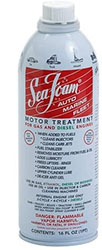
If you simply cannot find 100% gas then buy a can of “Sea Foam” (see it on Amazon). You can find it at most gas stations, Walmarts, and auto parts stores. It’s a fuel additive that prevents gasoline from going bad (when you haven’t been running the generator for a long time), protects the engine from getting fouled up by ethanol-gas, and cleans the carburetor.
Keeping Your Batteries Recharged
If you’ve always camped in places where you had electrical hookups, those hookups kept your batteries charged. But if you’re boondocking, you will need a way to juice them back up.
- You can use a generator to recharge your batteries. You simply connect a power cable from your generator to the 30amp or 50amp port on your RV. Your RV will have a “converter” already installed by the factory. This converter takes some of the power coming into your RV to recharge batteries. Read, “How Big of a Generator Do I Need for Boondocking?“
- The best way to recharge is with solar panels. All boondockers who dedicate themselves to living off-grid, eventually install solar panels. Read, “How Much Solar Do I Need for my RV?“
- Nearly all boondockers outfit their vehicles with several batteries. Read, “How Much Battery Power for Boondocking Will I Need?“
How Much Water Do I Need?
The amount of fresh water you have on hand is what will decide how long you can boondock…
- If your RV has a water tank, black tank, gray tank… You should test the capacity of your water tank by filling it completely with water, and then head out on a boondocking trip to see how long it lasts. Make sure your black tank and gray tank are completely empty before heading out, for the same reason.
- If you’ve never used your RV’s water tank before, you may want to sanitize it before boondocking. Read, “How to Sanitize an RV Fresh Water Tank“.
- If your vehicle does not have its own water tank, you will typically need a 1-gallon jug of water per person, per day. You will need more if you plan to spend a lot of time being active outdoors. Don’t forget to add more jugs of water if you want to cook with water, wash your face and hands, brush your teeth, and wash dishes. Read, “How Much Water Do I Need for Boondocking?“
How to Shower When Boondocking
- Boondockers with RVs always take “Navy-style” showers. Read, “How to Take a Shower When Boondocking“.
- If you don’t have an RV, you can buy a pop-up shower tent (see it on Amazon) and a 5-gallon shower bag (see it on Amazon)
- Most boondockers do not shower everyday. They usually shower once every few days, up to once every week.
- To save on electricity or propane, use the sun to heat up water. Leave a few one-gallon jugs of water outside under the sun.
- Get a membership to a national fitness center chain (24-Hour Fitness, Anytime Fitness, Planet Fitness), and use their shower facilities. Many boondockers do this.
What to do When Your Sewage Tanks Get Full
There are thousands of RV dump stations all over the country, yet it often remains a challenge to find one close by. Even more difficult is finding one with potable water to refill your tank. Read, “How to Find an RV Dump Station with Potable Water“.
Many boondockers dump their gray tank on the ground. Even though it’s technically illegal in most cases, gray water is practically harmless. It’s just soapy water with food particles mixed in. If you simply don’t want to pack up camp and move out just to find a dump station, you can usually dump it on the ground at your campsite. We recommend waiting until dark to do this to avoid a law enforcement officer seeing you. We also recommend doing this when it rains so that it washes away the gray water and eliminates the smell. Read, “Can I Dump My Gray Water on the Ground?“
What about the black tank? We don’t recommend dumping that on the ground. But that’s not to say that no boondocker does it. We are in fact, aware of some boondockers who do this. The fact is that you don’t have to. When you spend as much as time boondocking as we have, you will learn how to find a dump station near you.
Can You Heat or Cook Food?
At the very least, you will need a grill (just the cooking grill itself) and either a lighter or box of matches. And that’s all you actually need. All you have to do is arrange some large rocks in a circle and then lay the grill on the rocks. Gather firewood to start a fire…
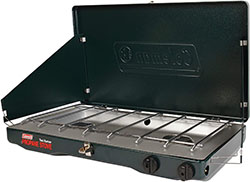
- It’s totally legal to collect dead and down wood for campfires. Read, “Is Collecting Dead Wood Legal?“
- Campfires may be restricted where you plan to go boondocking. Always check ahead to see what the fire restrictions areas. Read, “Can You Have a Campfire While Boondocking?“
- Can you start a fire? Don’t waste your time with flint rock or other fancy spark producers. Get yourself a simple butane lighter and a bottle of lighter fluid, and be done with it.
- Buy a fire extinguisher if your RV does not already have one. (see it on Amazon).
- The classic Coleman two-burner Stove (see it on Amazon.com) is very effective at accommodating most cooking needs, and uses only a single propane canister.
- The Blackstone Griddle (see it on Amazon.com) is extremely popular, but works better with a propane tank, usually the 5-gallon (20 pound) size.
- Yes, bring a frying pan, a pot, and a kettle. If you boondock long enough, you’ll want these to cook in.
- If your RV has a microwave oven, it will require 120 volt power to run. Most boondockers with RVs run their generator to power their microwaves.
- If your RV has a built-in cook-top or oven, it will require propane to run. It’s a good idea to buy couple of extra 5-gallon (20 pound) propane tanks to keep on hand.
Deep Frying
Deep frying has no place in boondocking. This is because deep-frying requires a lot of oil, and you’ll soon discover there is no place to dump that oil. If you dump it on the ground, that oil mixed with the scent of food, will attract raccoons, coyotes, and bears.
If you must deep fry, dump the oil into the campfire, and be prepared to stay up all night long until the oil burns off. Either that, or bring several glass jars (with lids) and store the used oil in there until you can toss them in a dumpster.
Making Coffee & Tea
The problem with most coffee makers is that they require 120 volt power, which means you need to run your generator. Most boondockers instead rely on a coffee-press and a kettle of water. All you need is to set the kettle on a propane cook top or a campfire and you’re all set.
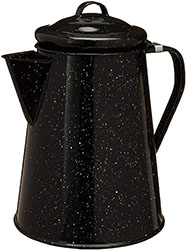
- Don’t buy a pretty colored kettle, or some newfangled, contemporary Euro-style kettle because it will get discolored-burns and blackened up with smoke. Instead buy a black, Granite-Ware kettle. It’s enamel coated which helps it heat up faster, but also prevents from staining and burn discoloration. (see it on Amazon).
- Also get enamel-coated coffee cups because they don’t break or crack, and you can reheat them directly on a campfire or cooktop. Other coffee-cups will easily break when boondocking because of the bumps of driving and from getting knocked over when trying to balance on your camp chair. (see it on Amazon).
Campsite Furniture
Campsite furniture does not have to be any different than what you might set up at an RV Park. However, we do have some recommendations…
- A fold up table is highly advised. Get a large table to use outdoors. You will want to use it as a countertop for preparing food, and as a buffet table for serving. Don’t get the lightweight aluminum tables you find at camping stores because they sag in the middle when you put a lot of weight on them, and they blow over easily in the wind. Get a sturdy plastic table with steel legs. Tables made by Office Star are pretty good. (see it on Amazon).
- Get a small fold-up side table to sit next to your camp chair. This table will become very handy to set down a Thermacell mosquito repeller, a set of binoculars, your favorite drink, etc.
Camping Outdoor Rug
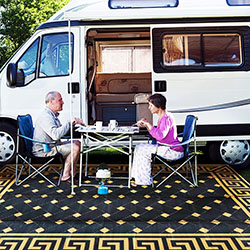
The primary purpose of an outdoor rug is to minimize the amount of dirt, sand, and gravel you track into your vehicle. It also makes for a cleaner place for your dog to lay…
- Get something made of plastic straw to keep weight down to a minimum, and to prevent mold and mildew from forming after rains. Get something large, measuring at least at least 9 foot by 12 foot (see it on Amazon).
- Get heavy duty tent stakes to secure the rug into the ground (see it on Amazon). Don’t buy the thin cheap stakes because they get yanked out during strong winds.
- Don’t forget to bring a hammer.
Will You Be Able to Keep Food Cold?
If you’re boondocking just for a few days, all you really need is an ice chest…
- Keep burger patties, sausage, steaks, on ice.
- Buy a cheap white styrofoam cooler just to keep meat cold, not frozen. Dispose of the cooler when you’re done.
- More expensive coolers like those made by Orca or Yeti work really well at keeping ice frozen for up to a week, but only if you buy the larger sizes (45 quarts or more), and if you fill it all the way up with ice.
- Dry ice is very effective at keeping food and drinks colder than water ice. When it melts, it produces vapor instead of liquid, making it effortless to empty. Most Walmart stores sell it.
If you plan to boondock for a week or more, then invest in a portable 12 volt refrigerator. This is designed to plug into the cigarette lighter of your vehicle. It runs on very little electricity, but is very effective at keeping food cold. These refrigerators have small storage spaces. But, it’s usually enough to keep meat and dairy from going bad…
- Whynter brand of portable refrigerators has the best reputation for quality among boondockers (see it on Amazon), but are very expensive.
If your RV has a built-in refrigerator, it likely has the option to run on either propane or 120 volt power. We recommend propane when boondocking. Otherwise, to run it from 120 volt power, you will need to fire up your generator. You can also find RV refrigerators that run on 12 volt power, but you will need a larger battery bank and a way to recharge those batteries.
Toiletries
Make sure to bring toilet paper! Make sure to bring paper towels. Tooth brush, tooth paste, soap, shampoo, wash cloth, a bath towel, deodorant, a razor, and all the things you’d normally want when at home.
Do You Need Cellphone Signal or Internet Access?
The good news is that there are more cellular towers today than ever before, making it easier to pick up a signal. Moreover, today’s phones and hotspot devices have better signal receivers than in the past. There’s a pretty good chance that wherever you boondock, you will get some kind of signal.
Satellite is always an option for boondockers, but tends to offer slower speeds, and is very expensive.
For tips and tricks on how to get Internet, and how to improve your cellular signal, read, “How to Get Internet While Camping“.
Where to Throw Away Your Trash
If you plan to boondock in the same place for a week or more, you will have a lot of smelly trash to get rid of…
- Don’t store bags of trash in the back of your pickup truck because raccoons and rats will tear it up and spread it around. Bears will be attracted to it as well.
- You don’t want to keep a full trash bag hanging from a tree or pole because it will attract flies to your camp.
- If you’re boondocking in a trailer, you can at least unhitch and drive your tow vehicle in search of a trash dumpster.
- Otherwise, your best bet is to burn your trash and use ways to minimize trash accumulation. Read, “How to Minimize Trash Accumulation When Boondocking“.
Protect Yourself Against Pests
Nothing ruins a camping trip more than flies, mosquitoes, and mice. Boondocking can be hit or miss when it comes to finding place free from these pesky critters…
- Mosquitoes are just about everywhere, even in the middle of the desert. Don’t rely on natural repellents, they don’t work. Deet is still number one when it comes to warding off mosquitoes. Permethrin and Picaridin are strong contenders. Thermacell works pretty well too. Read, “Keeping Mosquitoes Away From Your Camp“.
- Ticks are going to be a problem if you camp near water, or with tall grasses. Deet is also a big winner against ticks. Read, “How Do I Keep Ticks Away From my Campsite?“
- Chiggers are another nagging problem, particularly in moist environments and tall grasses. Again, Deet is the winner. Read, “How to Avoid Chiggers When Camping?“
- Mice will eventually find their way into your vehicle no matter how hard you try to keep them out. Some places are just fraught with mice while others just don’t offer any problem at all. You might be surprised at what the most effective mouse control device is. Read, “How to Keep Mice Out of Your RV“.
Medicines and First Aid Kit
Definitely bring allergy medication, because we guarantee that you will end up in a place that your immune system has no experience with. Bring cold medicines too because they work well at combating the effects of allergies. For that matter, bring allergy eye drops too.
- Bring Benadryl Itch Lotion (see it on Amazon). You can find it at any drug store. You will get bit by mosquitoes and this lotion works well at soothing the itch. If you don’t like Benadryl, then get Hydrocortisone Cream (see it on Amazon). It doesn’t work as well as Benadryl lotion, but still works and will help heal rashes too.
- Bring 70% Rubbing Alcohol (see it on Amazon). You can use it clean wounds and kill chiggers.
- Get a tube of Alocaine Gel (see it on Amazon). This is used for burns from campfires, cooking, and sunburns. Alocaine is just a blend of Aloe Vera and topical anesthesia. It’s pretty safe, but very effective.
- Buy a bottle of hydrogen peroxide 3% (see it on Amazon). This is just as good as alcohol for cleaning wounds, but without the burn, and better for treating kids. Many vets recommend pouring hydrogen peroxide on your dog’s wounds instead of alcohol.
- First Aid Kit – The kits you see on Amazon are OK. We recommend buying the items listed above, but also adding… cotton balls, cotton swabs, ACE wrap bandage, Band-Aids, scissors, Neosporin, tweezers, and a small squeeze bottle to flush out eyes.
You Will Need to Level Your RV
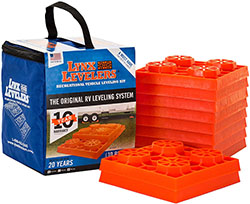
Boondocking means camping on uneven ground. You will need a way to level out your RV or vehicle so that you can camp comfortably on an even floor…
- Leveling blocks are still the easiest and most reliable way to level out your rig. Just drive your RV up on to these blocks to level it out. The Lynx Leveler is the standard of the industry and works pretty well. They also work well as traction to get you unstuck from the mud. (see it on Amazon).
- You will need a level to determine if your floor is level front-to-back and side-to-side. Don’t get a tiny level that sticks to the tongue jack of your trailer, it’s totally useless there. Get a standard carpenter’s level, at least 12 inches in length, and lay on the floor inside your RV to get the best indication. (see it on Amazon).
- You will also need wheel chocks to prevent your trailer from rolling forward or backward once you unhitch. Make sure to set these blocks first before you unhitch. The MaxxHaul Solid Rubber Block is still the standard of boondockers and is extremely durable. It’s what we use. (see it on Amazon).
- Stabilizer blocks are placed between the stabilizer jack and the ground. They are useful when camped on a slope, causing one or more stabilizer jacks to be fully extended. A fully extended stabilizer jack can no longer provide stability. Thus, adding blocks underneath the jack reduces the extension. We recommend using leveling blocks (see above). Don’t buy specialized stabilizer blocks because they are too expensive and don’t work any better than leveling blocks.
- Keep a small shovel with you. If you can’t add leveling blocks to level out one side of your rig, then you can always dig out a shallow trench for wheels to sit into. It’s the opposite of using leveling blocks.
Will You Be Able to Fix Your Vehicle?
If you decide to live life as a full time boondocker, something will break and you’ll have to fix it. It’s bound to happen…
- Keep a basic set of tools on hand (screwdrivers, wrenches, sockets, pliers, wire cutters, hammer, allen wrenches) as well as several sets of wood screws, metal screws, nuts and bolts, nails, Duck Tape, zip ties, et al. For more tools read, “Basic Tools You Will Need for Boondocking“.
- Keep a Bottle Jack handy. You’ll need this to raise your RV or trailer to change out a flat tire. A 10-ton Bottle Jack (see it on Amazon) is still pretty affordable ($40.00 to $60.00) and is strong enough to raise the largest RVs. You don’t have to buy it on Amazon, any Walmart or Auto Parts store sells them.
- Buy a Lug Wrench to remove wheels. If you get a flat tire, you will need this wrench to remove the wheel. (see it on Amazon)
- Buy a tire inflator. This is because it’s difficult to maneuver a trailer or motorhome around the gas station tire inflator. Don’t buy cheap inflators because they overheat. Make sure an inflator can do at least 100 Psi. The Kobalt Tire Inflator has been highly reliable for us… (see it on Amazon).
Can You Protect Yourself?
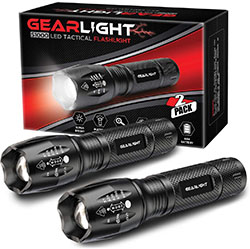
We don’t want to suggest that boondocking is more dangerous than staying in an RV Park. In fact, the opposite is true. There are more thefts, breaks-ins, and violence occurring at RV parks. However, you should always be prepared to protect yourself from people and animals…
- Guns can be legally carried on to federally managed lands. It’s always legal to shoot another person or animal if you’re being attacked. However, you still have to be in compliance with that state’s laws on weapon’s possession. Carrying your gun into Canada or Mexico is going to be a problem, however. Read, “Do I Need a Gun to Protect Myself When Boondocking?“
- Target shooting is a popular activity in boondocking. Read, “Can I Shoot My Gun on Public Lands?“
- There are certainly wild animals nearby when you’re boondocking. But rarely do they attack. Read, “Will I Get Attacked by Wild Animals When Boondocking?“
- If you plan to leave your RV unattended for several hours at a time, you might want to learn how to keep things secure. Read, “Is it Safe to Leave Your Camper While Boondocking?“
- Buy a High Lumens Flashlight. Flashlights are rated in terms of “lumens” which is the strength of light beam. A cheap, standard flashlight delivers between 25-50 lumens, which is nearly worthless for boondocking. Meanwhile, the strongest flashlights you can buy deliver 100,000 lumens, enough to burn holes through approaching zombies. We recommend something that throws between 1,000-2,000 lumens, which is still very affordable. (see it on Amazon).

